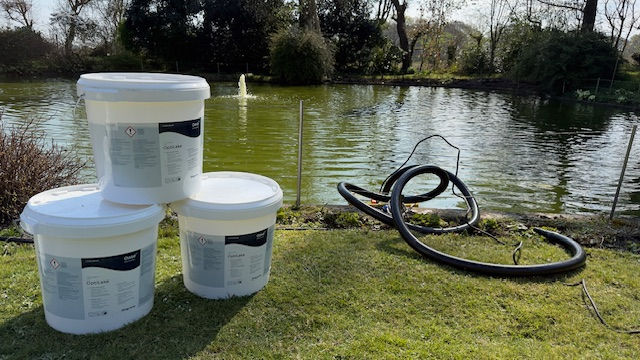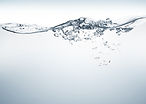Understanding pH and KH in Lakes and Ponds: The Role of OptiLake in Water Health
- Richard Fulford

- Aug 4
- 4 min read

Why Water Chemistry Matters
A healthy lake or pond relies on stable water chemistry. Two key parameters, pH and KH (carbonate hardness), play a vital role in maintaining a balanced and thriving aquatic ecosystem. In this article, we explore the pH/KH buffer system, what causes fluctuations, how to measure and manage these values, and how OptiLake can help restore and protect your waterbody.
What Is the pH/KH Buffer System?
The pH/KH buffer system is the water’s natural ability to resist pH changes caused by factors like CO₂ from plants and algae, especially overnight. CO₂ forms acids that lower pH, which later break down into compounds that raise it again, causing daily fluctuations.
The buffer system stabilises these shifts, and its effectiveness depends on a balanced level of carbonates and bicarbonates. When that balance is lost, pH becomes unstable. To maintain a healthy aquatic environment, KH (carbonate hardness) should be regularly tested and kept above 4 dKH.
How do I measure KH to know if my buffer system is intact?
KH (carbonate hardness) can be quickly tested using the OASE AquaActiv Water Analysis Kit (SKU 50571), which provides reliable results in German degrees (dKH).
Ideal range: 5–8 dKH
Minimum safe level: 4 dKH
Severe risk: 5 or below
Too high: Above 11 dKH
If readings are 6 or lower, or above 11, OptiLake should be applied to restore balance and protect water stability.
What is pH in Water?
pH is a measure of how acidic or basic (alkaline) a substance is, on a scale from 0 to 14. Pure water has a neutral pH of 7. Values below 7 indicate acidity, while values above 7 indicate alkalinity. The pH of water is determined by the concentration of hydrogen ions (H⁺) present in it.
Why pH Matters in Lakes and Ponds
A stable pH is essential for a healthy aquatic ecosystem. While most pond life can tolerate a pH range of 6.5 to 9, sudden changes cause serious stress. The ideal pH is 8.2, as it offers the most stability with minimal daily fluctuation.
Unstable pH can worsen issues like ammonia toxicity, reduce the health of fish and plants, and contribute to the formation of harmful organisms such as Cyanobacteria. Maintaining pH near 8.2 helps support a balanced, thriving environment.
Effects of Poor pH
Direct effects on fish:
Stress and weakened immune systems
Skin and gill damage
Greater risk of disease and parasites
Increased ammonia toxicity
Stunted growth and disrupted metabolism
Indirect effects on the ecosystem:
Damage to natural cleansing systems (plants and beneficial bacteria)
Breakdown in filtration → build-up of ammonia and phosphates
Murky, toxic water
Increased algae and harmful bacteria like Cyanobacteria
Maintaining stable pH is vital to support the lake’s self-regulating systems and overall water quality.
What Causes Poor pH?
Poor pH balance often stems from:
Decomposing organic matter (leaves, dead algae, uneaten food)
Algae blooms are triggered by excess nutrients and sunlight
Resulting breakdown → oxygen depletion + increased CO₂ → acid formation
☀️ Prolonged warm weather intensifies these effects. Higher temperatures boost the activity of bacteria, plants, and algae, all of which increase CO₂ production. This not only disrupts the pH but also puts greater strain on the buffer system.
🕒 Now is the ideal time to act, before seasonal changes cause significant imbalances. Proactive treatment with OptiLake can protect your pond against harmful fluctuations and help maintain water clarity, oxygen levels, and fish health through the warmer months.

How OptiLake Works to Correct and Protect
OptiLake is a comprehensive treatment that not only corrects poor pH but also protects the buffer system and enhances the lake’s natural self-cleansing functions. It works through a blend of natural components that offer multiple long-term benefits:
Key Benefits:
Bi-directional pH correction: Unlike standard pH adjusters, OptiLake can raise or lower pH as needed and self-regulates to prevent overcorrection, always aiming for the ideal pH of 8.2
True buffer system stabilisation: While products like baking soda only adjust in one direction and can’t maintain stability, OptiLake establishes a true equilibrium, ensuring long-term pH/KH stability.
Restores vital minerals: Supplies calcium and carbon — essential for healthy plants and bacteria. These minerals support nutrient uptake and improve natural cleansing, which reduces algae growth.
Reduces water discolouration: Binds to substances like tannins, helping to prevent browning.
Improves clarity: Increases biological breakdown of floating organics that cause turbidity.
Prevents limescale: Precipitates out excess materials that form limescale, prolonging the life of equipment.
Lowers toxicity: Boosts the nitrogen cycle, reducing ammonia, and precipitates harmful metals like copper.
Protects equipment in hard water: Reduces limescale build-up on pumps and filters, improving longevity.
Take Action
Test your pond’s KH today using the OASE test kit. If your KH is 5 or below, it’s time to use OptiLake to stabilise your water, support aquatic life, and protect your pond’s long-term health.
Need advice on the application or want to learn more?
Contact FishLife Pond Services - the science-led pond specialists.





Comments